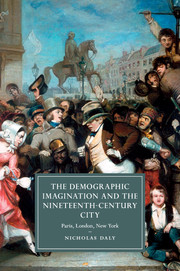Book contents
- The Demographic Imagination and the Nineteenth-Century City
- Cambridge Studies in Nineteenth-Century Literature and Culture
- The Demographic Imagination and the Nineteenth-Century City
- Copyright page
- Contents
- Illustrations
- Book part
- Introduction
- Chapter 1 Under the volcano
- Chapter 2 The streets of wherever
- Chapter 3 The ghost comes to town
- Chapter 4 The frenzy of the legible in the age of crowds
- Chapter 5 Fur and feathers
- Epilogue
- Notes
- Bibliography
- Index
- Cambridge Studies in Nineteenth-Century Literature and Culture
- References
Bibliography
Published online by Cambridge University Press: 05 April 2015
- The Demographic Imagination and the Nineteenth-Century City
- Cambridge Studies in Nineteenth-Century Literature and Culture
- The Demographic Imagination and the Nineteenth-Century City
- Copyright page
- Contents
- Illustrations
- Book part
- Introduction
- Chapter 1 Under the volcano
- Chapter 2 The streets of wherever
- Chapter 3 The ghost comes to town
- Chapter 4 The frenzy of the legible in the age of crowds
- Chapter 5 Fur and feathers
- Epilogue
- Notes
- Bibliography
- Index
- Cambridge Studies in Nineteenth-Century Literature and Culture
- References
- Type
- Chapter
- Information
- The Demographic Imagination and the Nineteenth-Century CityParis, London, New York, pp. 245 - 267Publisher: Cambridge University PressPrint publication year: 2015



